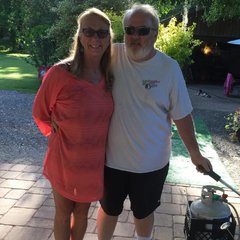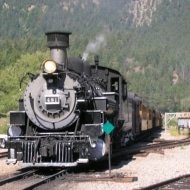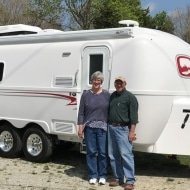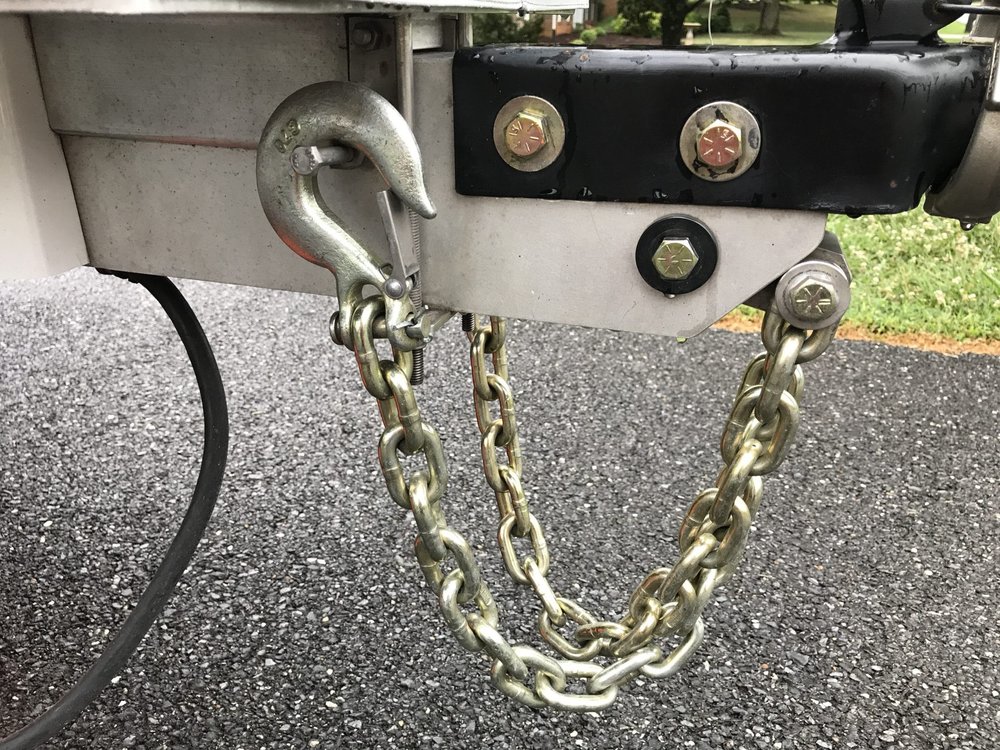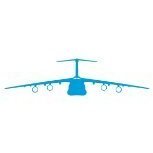Leaderboard
Popular Content
Showing content with the highest reputation on 08/06/2019 in all areas
-
We are spending our second night in Antigo, WI. We got here late Sunday afternoon and scoped out the Slide-Master factory. Early this morning we were at the plant where we were welcomed by the sales staff. Matt (sales person) took us to their other facility where all the aluminum fabrication is done. Here Tali and I unloaded and completely disassembled the upper assembly mounted on the slide in our truck. Then their team removed the bare slide and took it into the shop where they removed the older style latching mechanism and replaced it with the latest style. During the time they were doing the modifications, we returned to town to work with the sales and design folks to create our new slide. They truly build a completely customized product. They worked with us on all the different design issues so I ended up with a slide that incorporates all the features I wanted. I decided to go with a steel rather than aluminum frame for several reasons. — There is only a 10% weight increase due the additional amount of aluminum needed to achieve similar weight ratings. — The cost is significantly less allowing us to add features that we would not have at the higher price of the aluminum model. — I will be able to weld to it if need be. Matt is having drawings of the proposed design sent to us for final approval. You’d have to be dealing with the team at Oliver for service better than this. I highly recommend these folks if you’re looking for a custom slide at prices less than everyone else’s cookie cutter offerings. We drove from southern Idaho to Wisconsin instead of heading straight for Mississippi just to meet with these folks. I feel like it was well worth the extra time and expense to be able to get this level of service and this quality of a product. Tomorrow, we will reinstall the slide and head toward home. We left two days after the rally and headed for Alaska. We’ve driven nearly 13,000 miles and we’re still a thousand miles from home.4 points
-
2 points
-
I used Mike and Carol's great instructions to move my television to over the rear window. I bought this television mount from Amazon, and it says it can hold a maximum of 44 lbs. Maybe you can find out what mount Oliver is using currently.2 points
-
Only for the Salty Adventurers 2019 is shaping to be the best educational event yet. Set in one of the most dynamic geologic locations on Earth, this strip of ever-shifting sandy land will make you appreciate the planet we occupy. Carry your trailer wheels to a place that we can experience an ever-changing environment and the salty souls who inhabit it. To top off the video posted on the rally's site: Ribbon of Sand - North Carolina's Outer Banks, we also encourage you to watch the YouTube video that presents the new Bonner Bridge, which is a vital part to safe navigation for NC. The Oregon Inlet remains one of the most dangerous passages for any vessel anywhere on the East Coast and unless you’re bringing your camper via ferry system, you’ll be travelling over the new Bonner Bridge.1 point
-
I got a cheap string of Solar powered LED lights from Amazon, about 1” balls that we sometimes hang from the awning with Camco hooks that slide into the awning slot. They are not bright, just provide a mild ambience. We use them depending on the Campground. Sometimes dark is better. What’s really annoying is campers the have strings of bright LEDs everywhere ruining the night sky.1 point
-
In preparation for my ARE truck cap, I recently had installed (1 hour at $120 - the installers have a forklift) a Cargo Glide, 100% extension, 1500lbs cargo capacity, stops at every 12 inches. Crawl around in truck bed looking for that chair I thought was packed, careful not to bump my head on the truck cap, simply slide the bed out and take a look.1 point
-
I think you will find this is the one, it's the same one that's in our new Elite II, https://www.amazon.com/VIVO-Cabinet-Mounting-Monitors-MOUNT-M-FD27/dp/B01GGRJM4U/ref=sr_1_25?crid=13AD10W31V2Y1&keywords=rv+tv+mount&qid=1565031447&s=gateway&sprefix=rv+tv+%2Caps%2C158&sr=8-25 trainman1 point
-
Anderson has said to shut off the Ford stability system when it conflicts with the Anderson hitch. There are a few serious problems with this that must be considered. First, what makes anyone think that Anderson knows more about stability control in Ford trucks, than Ford? Second, if you get out of control because of a swaying trailer, or a skid on a slick surface, and have an accident, after you turned off the system, are you going to try and blame Anderson? I think Anderson just came up with a knee-jerk response to the problem and is being extremely irresponsible in just telling people to turn off their stability control system. Third, having a hitch system that tries to do both weight distribution and sway control in one unit, has a particular problem here. Weight distribution is a real need and the need for it is easily measured. That type of hitch is even recommended by Ford when the tongue weight is over 500 lbs, as I understand it. Fine. Use a WDH. But what about sway control? Nobody knows if they need it until they experience uncontrolled sway. Nobody that I know of has ever had a stability problem with an Oliver. So why do people want to buy an Anderson hitch? It's only because the Anderson fits the Oliver without fiberglass cutting, and because Oliver offers them as an option. And since the sway control comes along for the ride, it seems like a good idea. The devil is in the details. Now, the sway control issue is driving the discussion and the problems are showing up. If you need weight distribution, you get sway control whether you want it or not. And the sway control friction is not adjustable. Who know if it is too much, or not enough? Evidently, it is too much, because there is no stability problem anyway and the truck detects that something is going on that is causing instability, and throws a warning. The hitch is causing the instability. And the sway function is not adjustable. Bottom line: Modern tow vehicles have stability systems that re very good. Olivers are very stable trailers that don't need sway control, as far as I know. By trying to get weight distribution, you get anti-sway that interferes with the truck's system. People think they need anti-sway, but have no evidence that they do. My conclusion is that people are buying something they don't need, and then are being told to turn off an important safety system because of the problem it causes. And the people telling them to turn it off have an interest in selling them the very thing that requires them to turn it off, while accepting no responsibility for that recommendation. And there is no history of instability that would require it in the first place. People are buying this for insurance or out of fear or because they think there is no alternative. I bought my Oliver used and it came with an Anderson. It was so obviously a suspect design, that I have never used it even once. After towing in all kinds of conditions, high and low speeds, cross winds, passing trucks, severe weather, etc. There has never been the slightest instability of the trailer. In Texas one night, there were violent winds and tornado warnings as we went east. Extremely hard rain and hail. Semi trucks and other cars were pulling off the highway to park and to duck under overpasses, to get out of it. We cruised along and I wondered if Ollie might get blown over on it's side, or how much it would sway from he cross winds. It followed us along just fine. We've covered many miles at higher speeds and have never seen any sign of a sway problem. We have some good friends that tow with an F-150 and they do not use one either. This, even though they are above the 500 lb tongue weight point where Ford says to use a WDH. They have been all over the country and have never had the slightest problem either. Nobody has that I know of. Think twice before buying a sway control hitch. Especially when there seems to be no evidence that one is needed, and that they can upset the truck's system. Later, if you do decide you need it, you could always add a simple friction system that is adjustable and cheap, or you can add an electronic aftermarket system. If you ever do happen to have a sway problem, with any trailer that has electric brakes, the immediate fix is to simply apply the trailer brakes at the controller on the dash. This stops sway by making the trailer pull back while reducing speed. Some brands of fiberglass trailers are less stable than others and weight distribution can affect their stability further. But Olivers have proven themselves to be very stable. Overland had a great suggestion. If you need the weight distribution, but don't want the sway control, grease the cone clutch to make it ineffective. Then you could leave the stability system turned on.1 point
-
I prefer chains because they are much more easily adjusted for length, and a bunch of other reasons as well. Safety chain length is a very important part of the system and is often overlooked. The chains, or cables, need to be as short as possible without binding up in a jackknife position. I'm in the process of doing this to my Ollie as I think the supplied chains are too long. Back up your trailer in a tight turn as close as you can without TV/trailer contact. Stop there and measure the distance between the two mounting points, chains crossed. I will do this with the actual chain and connecting hardware I'm using. Leave just a little slack, maybe one link. I'm hoping that when I drop (lower gently that is) the trailer off the ball mount, the attached chains will prevent the trailer coupler, and the mounting hardware for the chains on the trailer frame, from ground contact. We'll see, there is only so much one can do if the design is off. This chain/cable length will be different for each TV/trailer setup. So supplying one length that "fits all" is not doing anyone any favors and could be hazardous in an emergency. If you have an articulating hitch, that could be very different, but I have no experience with those. Just my 2 cents. Dave1 point
-
Raspy and Dave, you are correct. The safety chains should each be able to carry the full load as there is no way to absolutely guarantee that both chains/hooks will share the load evenly. Having two chains allows provision for a backup in the event that one fails. I changed from the factory cable setup for several reasons, one being I got tired of cutting myself every time I had to wrestle the cables/hooks into compliance when attaching or un attaching them. Also they were only connected to the trailer tongue with 3/8ths bolts and fender washers. Lastly, the small hooks would not fit my truck hitch. I went with 3/8ths grade 70 chain and hooks and grade 8 bolts/nylon lock nuts. I believe that this chain has a breaking strength of 28,000 pounds. (That could be wrong, I haven’t looked that figure up in a while) anyway, there’re sufficient. Also don’t twist/knot the chains to achieve the correct length. That weakens them! Cut them to the correct length. I haven’t changed the break away switch cable but you are correct. The cable should not be infinite in length as our coiled cable is. It should be solid and just long enough so that if the trailer disconnects the brakes will apply before the chains reach their length limit. We (I) should get rid of the coiled brake safety cable version and get the true cable version that won’t stretch. It should be at the correct length. Also the brake safety cable should be attached to the tow vehicle or hitch directly only not to the safety chains. Sort of defeats the purpose if the chain breaks? I believe that the intent is to have an independent attachment point again for redundancy as with having two safety chains.1 point
-
This thread could easily morph in to a whole new thread about safety chains or cables.... But to answer the OP's original question about clevis hook orientation, I would say it is always better to have the hook enter from the top of the receiver hitch if possible. This is how I was taught by the heavy equipment operators where I volunteer. In the event of a separation, the force of the drop will be directed to a thicker and stronger section of the hook. Also, if there is a malfunction of the safety latch, gravity will be more in your favor if the hook opening is facing down. Of course, if the hook won't fit in that position, then do it the other way! Or, better yet, follow Raspy's advice and get an appropriate hook with a larger throat opening, or get a suitable quick link to make hookup easier. My Oliver came with Grade 70, 1/4" chain and hooks. The laws regarding the connection and strength of the chains vary State to State, as RnA posted above. BUT, the very strange thing about all these laws is that the chain strength requirement is not based on the WLL of the chain directly, but the Minimum Breaking Strength of the chain. Grade 70 chain has a Design Factor of 4. This means its Minimum Breaking Strength (MBS) is 3150 (WLL) x 4= 12,600 lbs. When I was looking in to all of this some time ago, I'm pretty sure I read that it is best practice for each of the two chain assemblies to be sized to independently carry the load in a separation event. With a MBS of 12,600 lbs however, each of the supplied 1/4" Grade 70 chain and hooks easily accomplish this for both Olivers. Trainman, I don't like cables either, for a whole host of reasons worthy of a different thread. The main one being they are not adjustable for length. If you google safety chain length you will understand why. Dave1 point
-
Recent Achievements


